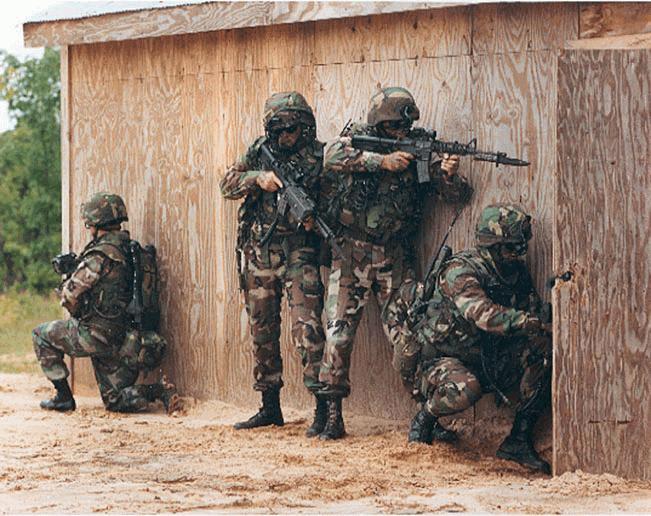|























| |
The infantryman will attach the Computer/Radio Subsystem (CRS) to his load-bearing frame. Over this goes the rucksack for personal gear. The computer processor is fused with radios and a Global Positioning System locator. A hand grip wired to the pack and attached to the soldier's chest acts as a computer mouse and also allows the wearer to change screens, key on the radio, change frequencies and send digital information. The subsystem comes in two flavors: The leader version has two radios and a flat panel display/keyboard, and soldiers have one radio. With the equipment, leaders and soldiers can exchange information. Soldiers using their weapon-mounted camera, for example, can send videos to their leaders. In its GEN II version, the computer and radio will be combined and embedded in new web gear. The system will be built around a series of cards the size of credit cards, but slightly thicker.

The CRS is integrated into the backpack frame in two sections. The upper portion contains two radios the squad radio and the soldier radio). The squad radio is based on a repackaged commercial radio and will be fully compatible with SINCGARS SIP. The soldier radio is based on a repackaged handheld commercial radio made by Motorola. This gives the soldier the ability to communicate with others in his squad, greatly improving situation awareness and survivability through increased command and control.
The lower portion of the backpack contains the computer and the global positioning system (GPS) modules. Integration of the GPS and radio into the CRS eliminates separate displays, controls and cases, thereby saving weight and reducing power requirements. Menu driven displays are controlled by the soldier from his Remote Input Pointing Device. This device is located on the chest strap and is operated by the touch of a finger. Some functions are controlled with two buttons located near his trigger finger, allowing the soldier to maintain a firing position. Imbedded into the load carrying frame are the antennas for the GPS and soldier radio. The open architecture of the CRS allows direct insertion of future upgrades in both hardware and software.
The Land Warrior software subsystem addresses the soldier's core battlefield functions, display management, and mission equipment and supply. The software subsystem includes tactical and mission support modules, maps and tactical overlays, and the ability to capture and display video images. The system also contains a power management module. Land Warrior will be interoperable on the digital battlefield. Designers set up the system so it can be updated as technology improves. The modular architecture allows for direct insertion/replacement with technology upgrades. The software subsystem allows the soldier to tailor the display, menus and functional operation of his system to his own mission needs and preferences.
The prime contractor for the Land Warrior System is Raytheon Systems Company. Subcontractors include Motorola, Honeywell, Omega, GENTEX and Battelle.
The soldiers who will actually use Land Warrior have been consulted every step of the way. Prime contractor Raytheon worked with experts at the U.S. Army Infantry Center at Fort Benning, Ga., in designing the system. They have taken the system to the users to ensure the system is headed in the right direction. The rucksack has quick-release straps so an infantryman can just drop it if the need arises. One problem the Army must overcome before fielding is power. Current batteries last about 150 minutes with all systems running. Other batteries under development by the Army's Communications-Electronics Command may push the time up to 30 hours. Individual portable power packs, possibly with form-fitting batteries that would be less obtrusive when worn as part of the soldier fighting harness, are being considered. Another possibility is development of a "sleep" mode that would automatically put the equipment on standby when not in use to conserve battery energy.
In order to be accepted by the Army, the Land Warrior System must weigh less than 80 pounds (including the TWS). This weight was selected to represent the current load being carried by today's soldier. The current weight of the system in development is 86 pounds.
The Army plans to test the Land Warrior system with a platoon from the 82nd Airborne Division, Fort Campbell, Ky. Later, a battalion-sized test is planned. Nearly 5,000 Land Warrior systems will be fielded by the end of 1999. First Unit Equipped (first system in the hands of soldiers) is currently scheduled for between 2000 and 2001. The Army is currently planning on contracting for 34,000 systems plus spares. The total systems cost is estimated to be approximately $70,000 each in FY96 dollars.
LW will be followed by a more elaborate soldier system that's expected to be fielded in the year 2003 as part of the Generation II/21 CLW program. GEN II will be more compact, energy efficient, producible, affordable and survivable, and will be more easily integrated into the digitized battlefield.
|
 We
will never forget 11/9/01...
We
will never forget 11/9/01...
